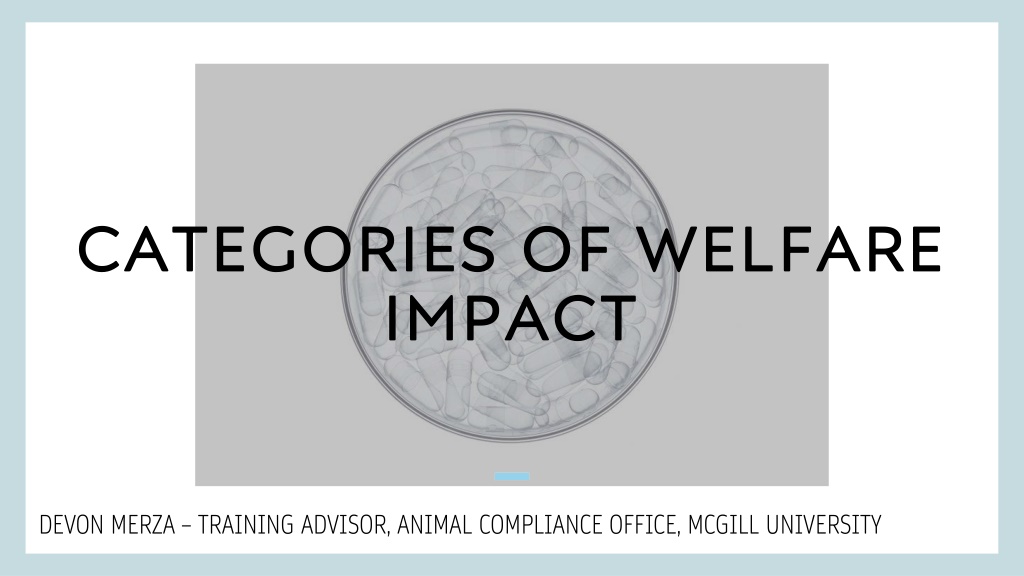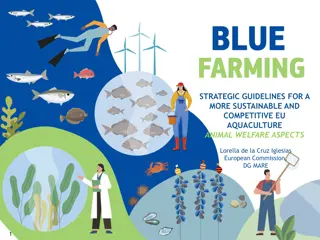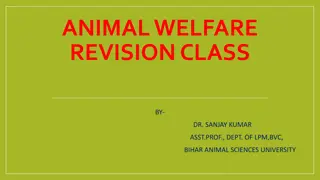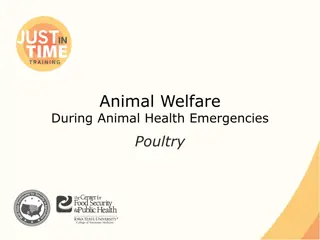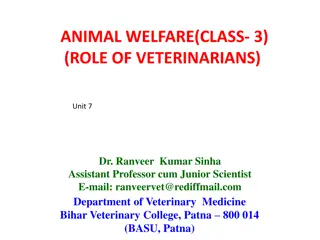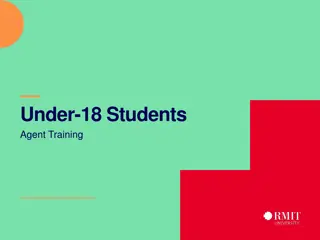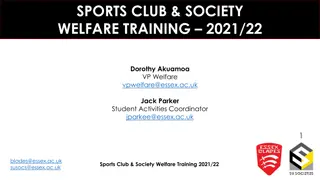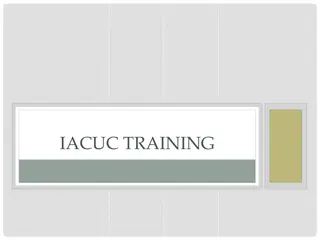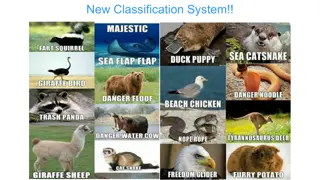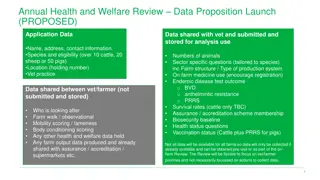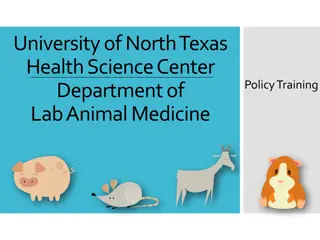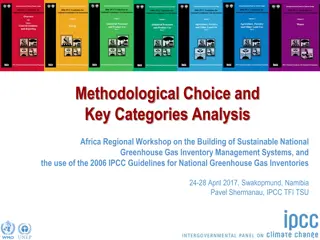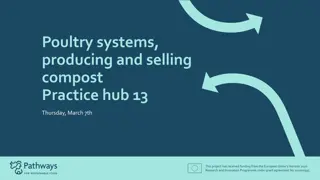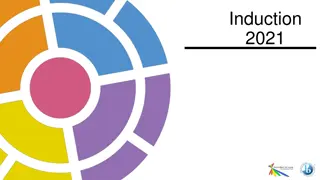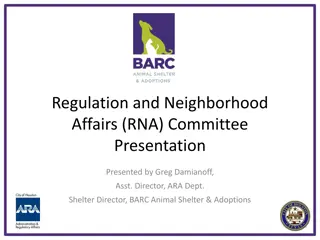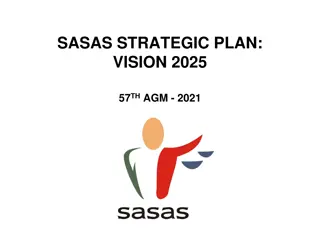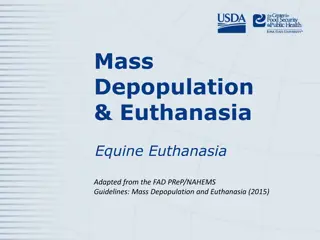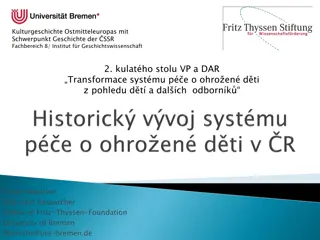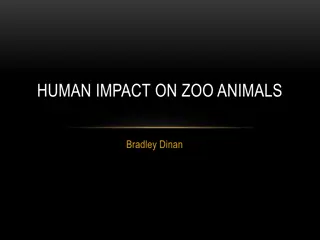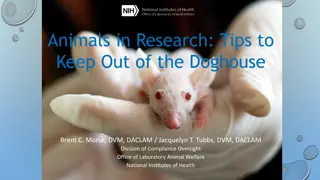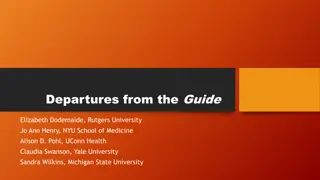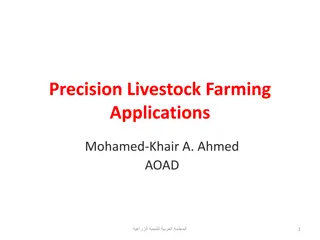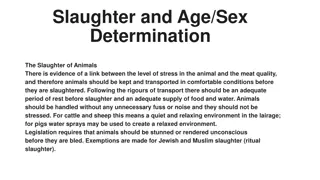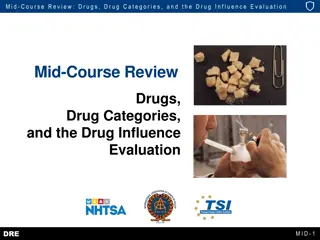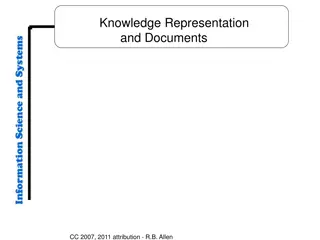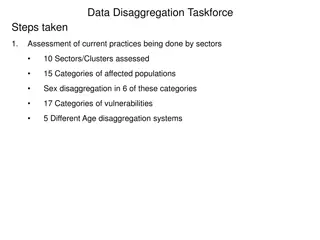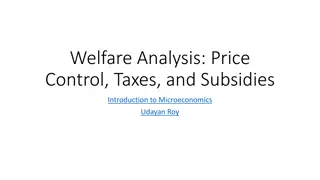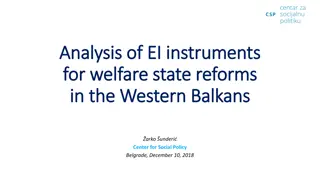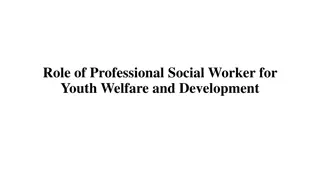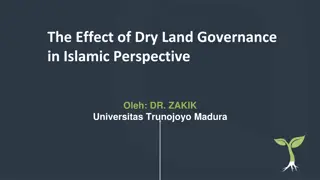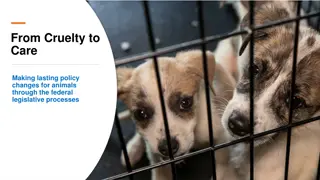Evolution of Welfare Impact Categories in Animal Research Guidelines
Canadian Council on Animal Care (CCAC) published updated guidelines titled "Categories of Welfare Impact" in 2024, replacing the Categories of Invasiveness. The new guidelines focus on animal experiences, procedures carried out on animals, and positive impacts on animal welfare. The categories (A-E) indicate the level of welfare impact, with Category A reflecting positive impacts. Continuous learning and review are emphasized in the classification process for accurate predictions and retrospective analysis for process improvement.
Download Presentation

Please find below an Image/Link to download the presentation.
The content on the website is provided AS IS for your information and personal use only. It may not be sold, licensed, or shared on other websites without obtaining consent from the author. Download presentation by click this link. If you encounter any issues during the download, it is possible that the publisher has removed the file from their server.
E N D
Presentation Transcript
CATEGORIES OF WELFARE IMPACT DEVON MERZA TRAINING ADVISOR, ANIMAL COMPLIANCE OFFICE, MCGILL UNIVERSITY
CATEGORIES OF WELFARE INTRODUCTION IMPACT On February 1st 2024, the Canadian Council on Animal Care (CCAC) published new guidelines titled Categories of welfare impact . These new guidelines replace used since 1991. replace the Categories of Invasiveness 2
CATEGORIES OF WELFARE DISCLAIMER IMPACT CCAC Correspondence on February 21, 2024: Certified institutions are expected to have developed an implementation plan by 2027 Institutions must continue to use the Categories of Invasiveness until 2030 3
SUMMARY OF DIFFERENCES WELFARE IMPACT CATEGORIES OF CATEGORY OF INVASIVENESS CATEGORIES OF WELFARE IMPACT Progressing A-E categories (Stayed the same!) Progressing A-E categories Focus on animal experiences Focus on procedures carried out on animals Species are a factor, different species experience the same procedure differently Species are not a factor Procedure is the only determining factor in categorization Procedure is 1 of 16 factors that influence categorization Does not account for positives to animal welfare Accounts for positives in animal welfare Category A typically did not require FACC approval Category A requires FACC approval Wildlife studies has its own Categories of Invasiveness Wildlife studies use the same Categories of Welfare Impact 4 Transgenic research assigned category D by default Transgenic research assigned categories based on prediction
WELFARE IMPACT CATEGORIES OF THE PROSPECTIVE ASSIGNMENT OF CATEGORIES OF WELFARE IMPACT SHOULD BE PART OF A CONTINUOUS LEARNING AND REVIEW PROCESS RATHER THAN A CONCLUSION, AS IT IS IMPORTANT TO VERIFY PREDICTIONS RATHER THAN SIMPLY ASSUME THEM TO BE TRUE. THE RETROSPECTIVE CATEGORIES OF WELFARE IMPACT DETERMINATION CAN ULTIMATELY BE USED TO IMPROVE THE ACCURACY OF THE PROSPECTIVE PROCESS . CCAC 5
REINTRODUCING THE CATEGORIES
WELFARE IMPACT THE CATEGORIES CATEGORIES OF 5 Categories (A-E) Category A reflects positive welfare impacts Categories B-E denote progressing negative welfare impacts The category is determined by the following factors: Severity *Frequency or *Duration *For ease of application either the frequency or the duration of the impact should be considered, whichever has the higher impact. 7
CATEGORIES OVERVIEW WELFARE IMPACT CATEGORIES OF CATEGORY WELFARE IMPACT DESCRIPTION A Positive Animal welfare is improved B Mild negative Low severity, low frequency or short duration Low severity, medium-high frequency or medium-high duration; OR Medium severity, low-medium frequency or short-medium duration C Moderate negative Medium severity, high frequency or long duration; OR High severity, low frequency or short duration D High negative E Severe negative High severity, medium-high frequency or medium-long duration 8
CATEGORIES BASED ON THE SEVERITY, FREQUENCY OR DURATION OF THE IMPACT WELFARE IMPACT CATEGORIES OF Severity Severity Positive Positive Low Low Low Low Low Low Medium Medium Medium Medium Medium Medium High High High High High High Frequency or Duration Frequency or Duration Any Any Low or Short Low or Short Medium Medium High or Long High or Long Low or Short Low or Short Medium Medium High or Long High or Long Low or Short Low or Short Medium Medium High or Long High or Long Category of Welfare Impact Category of Welfare Impact A A Positive Impact Positive Impact B B Mild negative impact Mild negative impact C C - - Moderate negative impact Moderate negative impact D D- - High negative impact High negative impact E E Severe negative impact Severe negative impact 9
FACTORS OF INFLUENCE WELFARE IMPACT CATEGORIES OF 16 factors influence the experiences of animals during scientific studies These factors can be grouped into 3 categories or as the CCAC refers to them Steps Attributes of the Environment Attributes of the Animal Attributes of the Scientific Procedure 11
The 16 Factors will be graded separately (A-E) for each study WELFARE IMPACT CATEGORIES OF segment to determine the Category of Welfare Impact letter. 12 The CCAC has provided this calculator on their website.
NOTICE OF EXAMPLES WELFARE IMPACT CATEGORIES OF All examples listed in the following sections are purely for demonstration purposes. They should not be seen as reflective of their true category. The CCAC has provided minimal definitions of letter categorization for each factor. The assignment of letter categories for specific circumstances will be determined by the FACC. 13
THE ENVIRONMENT WELFARE IMPACT CATEGORIES OF FACTORS SUMMARY The welfare of animals in scientific settings is affected by confinement. Enriched conditions may lead to a preliminary Category B, while adverse conditions warrant higher categories. Housing and Husbandry Relocation and transportation For wild animals in captivity, a preliminary Category C or higher is recommended. Transportation is recognized as a likely source of negative welfare impact, with severity based on factors like stocking density and duration. Examples: Lab mice housed with enrichment = B 14 Marmosets, caught in the wild and housed with enrichment = C
THE ANIMALS WELFARE IMPACT CATEGORIES OF FACTORS SUMMARY Handling conditions, such as extracting fish from water or conducting procedures during inappropriate phases, can intensify negative welfare impacts. Species, Strain, and Sex of the Animals Strain, sex, age, and developmental stage are critical considerations, with juvenile or elderly animals potentially facing heightened impacts. Age and Developmental Stage of the Animal Whether the Animal is Domesticated or Non- Domesticated Non-domesticated animals may be more affected due to retained wild adaptations. Domesticated animals, having experienced early-life exposure to humans, may exhibit reduced fear and stress responses. Inherent Welfare Status of the Animal Energy Status or Body Condition Inherent welfare status, including pre-existing conditions, plays a role, as does body condition and energy status. Social Disruption The Previous Experiences of the Animal Examples: 15 Known Aspects of Individual Animals Mice socially housed with no signs of social stress = B Adult dogs raised with little human contact = D
THE SCIENTIFIC PROCEDURES WELFARE IMPACT CATEGORIES OF FACTORS SUMMARY Drawing on experience, individuals predict pain and distress levels, emphasizing long-term consequences. Considerations encompass methodological refinements, the quality and frequency of monitoring, and the humane killing method. The Scientific Procedures The appropriateness of the setting, the expertise of personnel, and animal habituation/training are also integral factors. Monitoring Humane Killing Method The Setting in Which the Scientific Activity is Being Conducted Positive reinforcement training, reducing distress, is recognized with a Category A impact. Skill and Experience of the Personnel Examples: Whether or Not the Animal Has Been Habituated or Trained Injection of saline to a mouse by a trained student with months/years of experience working with mice = B 16 Cervical Dislocation without anesthesia of a mouse by a student who just completed training = C
CCAC PROVIDED EXAMPLES WELFARE IMPACT CATEGORIES OF A B C Training with positive reinforcement (and no form of deprivation) Brief restraint for physical examination of habituated animals Weekly blood sampling Subcutaneous injections done more than once weekly Evaluation of responses to a positive stimulus with which the animal can choose to interact (e.g., a puzzle feeder containing a preferred food item) Brief exposure to a stimulus that the animal may find mildly stressful, with opportunity to escape (e.g., vocalization playback not involving distress calls) Oral dosing of novel chemical entities where effect has not been previously characterized Short periods of food deprivation for longer than would occur in nature Diet preference study where all diets are palatable and nutritionally complete and balanced Weighing, handling for body condition score of habituated animals Forced treadmill exercise done greater than once every 72 hours One time intramuscular injection Surgical implantation of some permanent devices (e.g., indwelling femoral catheter) using multimodal analgesia Subcutaneous implants 17 Telemetry implants in large fish
CCAC PROVIDED EXAMPLES WELFARE IMPACT CATEGORIES OF D E Any protocol that causes permanent changes in an animal s physiologic state such that it results in a chronic negative disease condition Repeated social hierarchy disruptions (including potentially aggressive interactions) Experimental autoimmune encephalomyelitis models Sample collections done under multiple general anaesthesia (greater than two general anesthesia events in 24 hours), e.g., serial cerebrospinal fluid collections Social defeat model and witness to social defeat model Live predator-prey interactions, including use of live animals as bait Chronic feed restriction Sciatic nerve constriction Metastatic tumor model in rodents with early endpoint Parabiosis Large wild mammal capture and release Surgical castration 18 Craniotomy
FUTURE DIRECTIONS AND POTENTIAL CHALLENGES WELFARE IMPACT CATEGORIES OF FACCs will need to determine letter categories for baseline situations for all 16 factors. AUPs may need to be further segmented by groups of animals following similar experiences rather than study segments Potential implications for the training program and discussions of post-training practice and supervision in labs. 19
SUMMARY WELFARE IMPACT CATEGORIES OF Categories of Welfare Impact is a major change from the Categories of Invasiveness. As with all major changes, this will significantly change processes and will create new challenges. However, bringing the focus to animals experiences throughout their lifetime will increase animal welfare exponentially and show in time, to be beneficial for scientific discovery. 20
THANK YOU DEVON MERZA EMAIL|ACO WEBSITE
